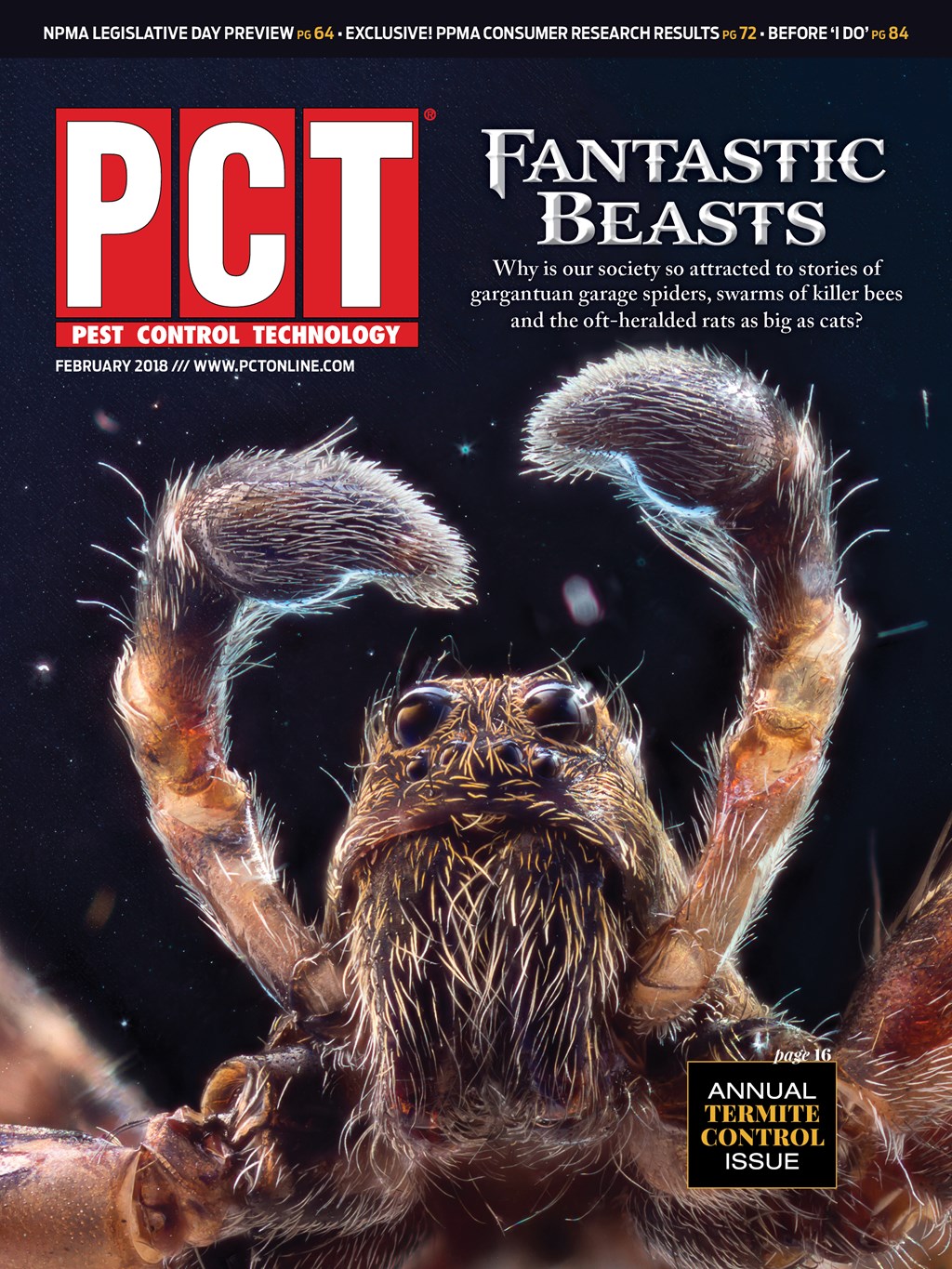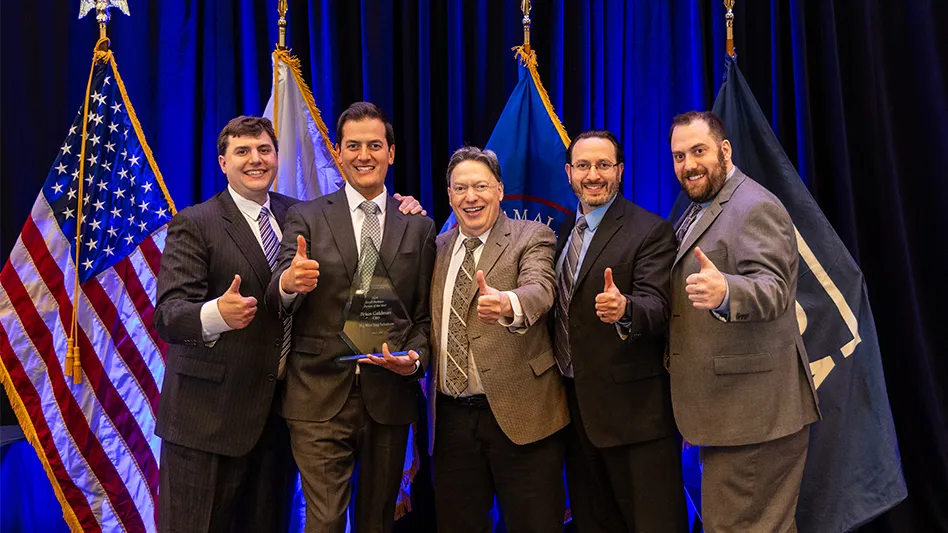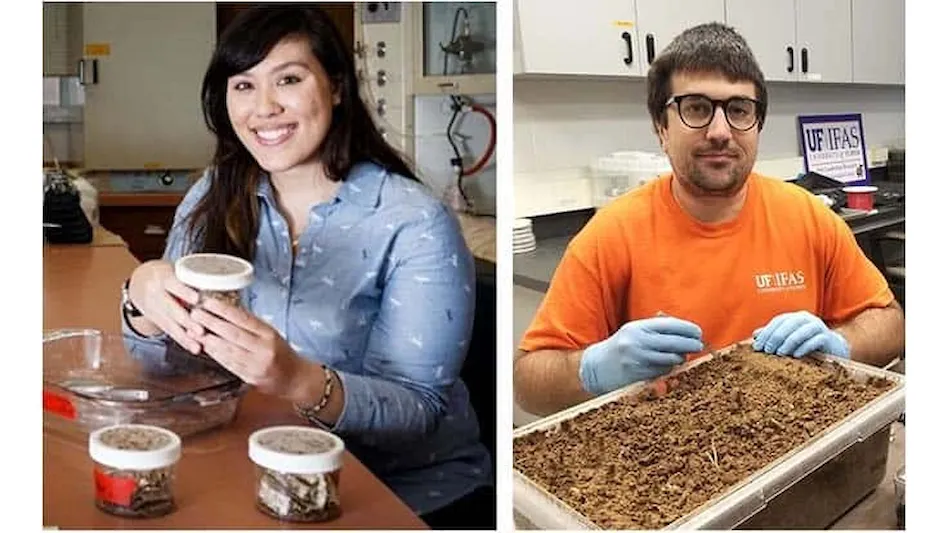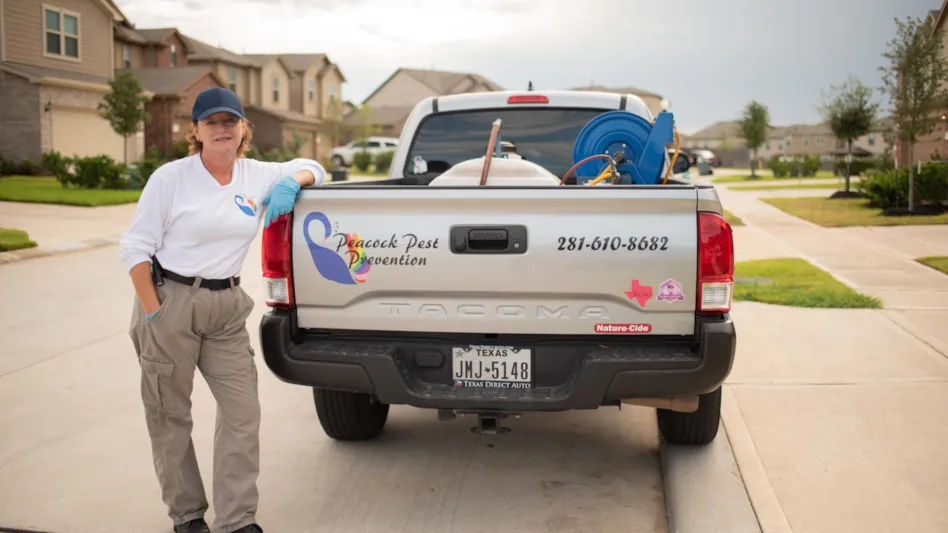
The desert subterranean termite Heterotermes aureus (Snyder) has not historically received the attention that other subterranean termite species have in the United States. This is partly due to the devastation to wood in structures caused by the subterranean termites in the genus Reticulitermes in the southeastern U.S. and California, heavily populated areas of the United States where termite damage affects millions of homeowners. The invasion of the Formosan subterranean termite, Coptotermes formosanus Shiraki, as a major pest in the Southeast and Hawaii also became a necessary focal point for research.

H. aureus occurs in the desert areas of southeastern California, southwestern Arizona, along the eastern coast of Baja California, and on the mainland of Mexico in the states of Sonora and Sinaloa (Figure 1) (Haverty and Nutting 1976). Significant research on H. aureus did not begin until 1971. These studies were not centered on how to control this termite pest, but rather on the role that H. aureus, and its comrades, played in the ecology of the Sonoran Desert (Haverty and Nutting 1975). Studies in the late 1980s refined the nature of the colonies of this species and what influenced their foraging (Jones et al. 1987; Jones 1990). During this period, the population of Arizona and southeastern California grew rapidly, with a tremendous increase in the number of houses in Phoenix, Tucson and in the vicinity of Palm Springs. As H. aureus became a recognized, important economic pest, the industries concerned with termite control took an interest in evaluating soil insecticides and bait systems for management of this resident of the Sonoran Desert.
TERMITES IN DESERTS. Termites are ecologically and economically important insects that feed on cellulose, principally in wood. In forests and woodlands of the western United States, termites commonly dine on dead trees and on stumps, as well as woody debris on or buried in soil. Some species specialize on herbaceous plants and grasses and the dung of herbivores. A few species of termites, including H. aureus, are destructive to wood and wood-based products in and around buildings.
Insofar as they degrade woody debris, termites are highly beneficial by returning nutrients to the soil and bringing soil from lower strata to the soil surface (Haverty 2001). H. aureus and another desert subterranean termite, Gnathamitermes perplexus (Banks), are dominant factors in soil turnover, litter decomposition and nutrient cycling in the Sonoran Desert. Together, they have been reported to move about 744 kilogram/hectare of soil to the surface each year. This increases the clay content of surface soils, alters the pH from slightly acidic to basic, and enriches surface soil with organic carbon, nitrogen, calcium, magnesium, potassium and sodium as a result of depositing feces and/or saliva in their workings at the surface (Haverty 2001).
A simple computer model constructed by Haverty and Nutting (1975) simulated the consumption of superficial dead wood in a desert grassland by H. aureus over a period of one year. The model was designed to run on mean daily temperature and daily rainfall and predicted that H. aureus foragers made 4.61 x 1010 visits to the surface per hectare during the year of simulation. It calculated that this species removed dead wood at the rate of 78.9 kg/ha/year, which represented 3.7 percent of all of the superficial dead wood and 17.5 percent of the annual production of superficial dead wood. This positive role of H. aureus foragers in the Sonoran Desert ecosystem is easily forgotten when they damage our homes or the contents of our homes.
TERMITES IN THE SOUTHWEST. There are numerous species of termites found in the southwestern United States, primarily in California and Arizona. Only a few species range into the Pacific Northwest and northern Rocky Mountain regions. Nearly all species presently found in the West are native.
The genus Reticulitermes is the most common of the subterranean termites in North America and is ubiquitous throughout most of the West. Reticulitermes generally occurs in grassland, oak-pinyon-juniper associations and coniferous forests above 3,740 feet in Arizona. In contrast, H. aureus occurs in desert and desert grasslands below 4,000 feet (Figure 1). Near the northern limit of its range (above 33° Northern Latitude), H. aureus probably does not occur above 2,625 feet. At the southern border of Arizona, this species may occur at elevations up to 4,000 feet.

The distribution of H. aureus is limited by the lower temperatures and higher elevations in the northern part of Arizona, whereas Reticulitermes is limited by the low moisture and high temperatures of the lower deserts (Figure 2). Reticulitermes may invade areas occupied by H. aureas under suitable moisture and temperature conditions provided by urban and riparian situations (Haverty and Nutting 1976).
Reticulitermes sp. and H. aureus are similar in their superficial appearance and general biology. Much of their behaviors are similar, but there are distinct differences. The adult, winged form, or swarmers, of Reticulitermes sp. are dark in color and fly during the day in the winter (January and February) in Arizona. The winged adults of H. aureus are pale, rather than black, and fly in the evening in the summer (July through September), rather than during the day (Nutting 1969). The workers and soldiers of H. aureus are similar to Reticulitermes sp.: the head of the soldier also is oblong and rectangular, but the mandibles of H. aureus are thinner than those of Reticulitermes sp. (See Baker et al. 2005).
EARLY H. AUREUS STUDIES. Prior to the development of baits for control of subterranean termites, knowledge of subterranean termite biology was, in my opinion, not that important for control strategies. Prevention and control of subterranean termites were accomplished by placing a chemical barrier in the soil prior to, or after, the construction of the foundation. We knew that subterranean termites lived in the soil and would feed on the wood in the structure if allowed access to it. A continuous, toxic or repellent barrier kept the termites from gaining access to the building. This is pretty simple. For post-construction termiticide spot treatments the difficulty was determining exactly where the termites were entering the building.
However, to make baits effective, research to gain knowledge of foraging behavior became very important. This is as true for the desert subterranean termite as it is for the subterranean termites of the southeastern United States and the exotic Formosan subterranean termite.
FORAGING CHARACTERISTICS. In 1970, a large research project was initiated to study the comparative ecology of desert ecosystems in North America and South America. One aspect of this project was to ascertain the role of termites in the Sonoran Desert in Arizona and the Chihuahuan Desert in New Mexico. The research in the Sonoran Desert was conducted by Professor William L. Nutting and his graduate students, Jeffery P. La Fage and me.
Probably the most serendipitous finding of this research was the discovery of toilet paper as a foraging substrate for H. aureus (Haverty 2001). Using toilet paper as “bait,” we were able to make the first estimates of the density of colonies, colony size, foraging territories and the number of foraging access points. The effect of temperature and moisture on foraging behavior was very quantitative and accurate (Figure 3) (Haverty et al. 1975).
We estimated that the density of H. aureus colonies on our research site was 470.5 per acre. Our estimate of the number of foragers in a typical colony was 22,632. These colonies had, by our estimates, an average foraging territory of 135 ft2. Of the 1,600 rolls of toilet paper on our site, H. aureus had, at one time or another, attacked 22.8 percent of them (Figure 4, page 44). Keep in mind that these parameters were estimated without the technologies that were developed later — dyes or stains for marking foragers, agonistic behavior between groups of foragers and genetics of foragers for delimiting colonies. These newer technologies greatly improved our understanding of the biology of H. aureus.


Jones (1990) brought newer technology to the Sonoran Desert to re-investigate colony parameters of H. aureus. To delineate territorial boundaries of individual colonies, she introduced release-and-recapture of stained termites and agonistic behavior among termites from different foraging groups to determine colony foraging territories. What she found was that the previous estimates of 135 ft2 for a colony territory were very low. Instead, she estimated colony foraging territories to range from 140 to 35,693 ft2. Her estimates often included the area between the extremes of her research plots (7 of the 12 plots) and could have greatly overestimated foraging territory of some of these colonies.
The business of determining foraging territory is difficult. If pieces of wood or monitoring/bait devices are scattered over a property or around a structure, should you encompass all of the space found within a polygon surrounding the stations as a foraging territory? This could tremendously overestimate the foraging territories. Constructing a polygon around monitoring/bait stations occupied or used by a colony includes a lot of real estate that termites are not necessarily using or defending (Thorne 1998). Rather, the concept of a foraging range may be a more appropriate descriptor of where termites are working than an arbitrary foraging territory.
Baker and Haverty (2007) studied H. aureus colonies around three structures in the vicinity of Tucson, Ariz. They used the minimum total foraging distance potentially traveled by members of a colony as a variance of foraging range. This is computed as the sum of all the linear distances between all possible pairs of monitoring/bait stations occupied by, and defended by, a colony. Their research acknowledged that foraging galleries do not always follow straight lines — at the same depth in the soil — between monitoring stations or other food sources. Rather these galleries are a vast network of interconnected tunnels and chambers within the soil, at various depths, and they avoid obstacles interspersed among food sources. Baker and Haverty (2007) acknowledge that it would be naive to assume that all pairs of monitoring stations/baits are connected with their own separate tunnels; some monitoring stations could be connected in series (along a foundation wall, for example) and this would make total foraging distance smaller.
They found that the maximum distance between monitoring stations occupied by the same colony of H. aureus ranged from 85 to 118 feet. Assuming that members of the same colony could be visiting all of the stations utilized by the colony, the minimum total foraging distance of the colonies at these structures ranged between 975 and 7,963 feet. These distances are affected by the size of the structure and the number of occupied monitoring stations.
Foraging territories, foraging ranges and foraging distances are an academic approach to describing or comparing colonies, initially or over time. From a practical standpoint, it is probably more advantageous to know how many monitoring or bait stations are occupied by the same colony. Baker and Haverty (2007) found one or two colonies per structure and that the percentage of monitoring stations visited by H. aureus in their study ranged from 43.8 percent to 59.0 percent. If these were bait stations, that would be very significant.
NUMBER OF FORAGERS. The first attempt at estimating the number of H. aureus foragers in a colony was done by Nutting’s research group. During their studies, they made weekly checks and observed an average of 3.78 H. aureus foragers per roll of toilet paper. They used the data from Bodine (1973) and Haverty et al. (1975) to obtain an estimated 22,632 termites per colony. Their estimate was speculative, but they felt it was not all that unreasonable.
Baker and Haverty (2007) estimated foraging population size in three colonies around structures in Tucson. They used the mark-release-recapture and triple mark-release-recapture techniques. Their estimates ranged from 64,913 to 313,251 termites among the colonies. These techniques are not without controversy and could very well overestimate the populations, because the techniques assume all marked individuals returned to the bait stations survive and randomly mix with the others in the colony. This was clearly not the case.
So, one person’s colony population estimate is probably as good as another’s. The actual average number probably is greater than 22,632 foragers per colony but less than 313,251 foragers per colony.
DESERT TERMITE FORAGING. Nutting and his students wanted to examine the abiotic factors affecting or regulating foraging activity of H. aureus. At our research site south of Tucson, we removed all woody debris from an area approximately 50 meters by 50 meters. On this cleared ground, we placed 16 grids of 100 rolls of toilet paper one meter apart (Figure 4). Every week for 53 weeks, we examined 1,200 of these toilet paper rolls over a 24-hour period, 100 rolls every two hours. (Four hundred rolls were untouched for the year to determine how much paper was removed by termites and the quantity and quality of soil brought to the surface in or under the rolls.) We determined whether termites were or had been feeding on each roll, the species in the bait or that had been in the bait, and, if present, the approximate number of foragers.
H. aureus foraged day and night throughout most of the year with minimal activity from December through February. Foraging activity increased moderately in the spring and fall and was high but erratic during the summer months. With increasing temperature the number of foragers generally increased. Rainfall had little effect on foraging when daily mean soil temperatures were below 20° C at the toilet paper roll-soil interface. However, even the slightest amount of rain during the hot summer months greatly increased foraging intensity. Above 33°C, even with precipitation, foraging numbers plummeted. Our overall conclusion from this study was that foraging activity is not endogenously controlled; rather it is exogenously controlled by soil temperature and moisture (Figure 3) (Haverty 2001).
Jones et al. (1987) examined the effects of abiotic factors on foraging of H. aureus. They concluded “seasonal variations in the numbers of foragers were consistent with previously reported data” by Haverty et al. (1974). They also examined a biotic factor, namely vegetative cover. They found that “… termite attack on toilet-paper baits was greatest at sites having the most vegetative cover,” while “continued foraging at an already occupied toilet-paper bait was unrelated to vegetative cover.” They also concluded that “that termites forage randomly with respect to distance between potential food sources” (Jones et al. 1987).
SUCCESSFUL BAITING PROGRAMS. Even though many of the results reported here were published many years ago, they have importance in evaluating presence or absence of termites in a bait station. Unlike humans, the H. aureus does not work an eight- or 10-hour shift. They forage when it is most favorable for them, even if this is in the middle of the night. If a technician is examining bait stations in the winter months in the Tucson area, no foragers are likely to be found on the bait. There might be evidence of prior activity, but the termites probably will not be there. Likewise, if the technician has the unfortunate assignment of checking bait stations in the hottest part of the summer before the monsoon rains begin, foragers might not be in the bait stations. Rather, if termites are foraging, it is likely to be during the night or early morning when soil temperatures are cooler.
Atkinson et al. (1998) evaluated an early version of the Sentricon system that featured a monitoring phase followed by a baiting phase when the stations were attacked by H. aureus. They utilized two very large structures, the San Xavier del Bac Mission and a private, multilevel, 5,000 ft2 residence in the Tucson area. The active ingredient in the bait at that time was hexaflumuron deployed in a bait tube. At the mission, 8 of the 16 in-ground stations were active with H. aureus. At the private residence, 5 of the 52 in-ground stations were active. The termites were controlled or eliminated after six months at the mission and after 16 months at the residence.
In 2010, Dow AgroSciences introduced the Sentricon system with Recruit HD termite bait labeled for a once-per-year service interval. Two residences in Tucson suburbs were used to evaluate the efficacy of this product from spring 2012 until summer 2015. Residence 1 was a 2,850-ft2 building in the Catalina Foothills with a two-car garage and extensive surrounding patios and driveway. Residence 2 was a 2,750-ft2 building near the Rincon Mountains with a three-car garage and a pool with patio. Both residences featured natural desert vegetation on the property and colonies of H. aureus, G. perplexus, and one or more Amitermes species. Residence 1 had 32 stations and Residence 2 had 28 stations around the perimeter that was not covered by a hard surface.
Live termites were found in 12.5 percent of the stations at Residence 1 and 14.3 percent of the stations at Residence 2. Live termites were found in stations only in spring (April), summer (July) and fall (October); none were seen in the winter (January). Additional stations exhibited signs of feeding, but no live termites were found. This corresponds to the findings of Haverty et al. (1974) and Jones et al. (1987). Four of the stations at these residences were infested with Amitermes, not H. aureus. The efficacy of the Recruit HD termite bait against Amitermes is unknown. Amitermes do not infest buildings, only buried wood. However, to the untrained eye, the workers of Amitermes could be confused with those of H. aureus. Neither residence had a subterranean termite infestation at the end of the case study.
WHAT WE’VE LEARNED. All of this research has provided us with some interesting findings:
- H. aureus is the predominant subterranean termite attacking structures in the Sonoran Desert of Arizona and California. H. aureus
- is important in enriching desert soils and bringing soil from lower strata to the surface. H. aureus
- recycles about 17.5 percent of the production of dead wood in the Sonoran Desert. H. aureus
- readily feeds on baits, whether they are paper, cardboard, wood or commercially available synthetic material.
- Estimates of foraging territories of H. aureus range from as little as 135 ft2 to 35,693 ft2, and the linear distance between foraging sites for a colony can be as much as 118 feet.
- Typical colonies of H. aureus contain from 22,632 to 313,251 foragers. H. aureus
- forages day and night through most of the year with minimal activity from December to February.
- Rainfall and the resulting increase in soil moisture during the monsoon season greatly increased foraging by H. aureus.
- Attack rates by H. aureus at commercial bait stations is equivalent to those reported in early research studies with toilet-paper or corrugated-paper baits.
- Other species of termites can be found in Sentricon stations with Always Active technology, but these species do not infest buildings and shouldn’t be confused with H. aureus.
The author has long studied the biology of termites in Arizona. He began in Arizona with the first ecological and behavioral studies of H. aureus. Currently, he is a consulting entomologist specializing in wood-destroying insects with an emphasis on termites. He has authored 108 publications on termites and nearly 50 publications on other wood-destroying and forest insects.
References
Atkinson, T. H., M. S. Smith, and R. E. Williams. 1998.Control of structural infestations of Heterotermes aureus in Arizona with the Sentricon System. Down to Earth 53(2): 18–26.
Baker, P. B., R. J. Marchosky, Jr., and A. J. Yelich. 2005. Arizona Termites of Economic Importance. cals.arizona.edu/pubs/insects/az1369.pdf
Baker, P. B., and M. I. Haverty. 2007. Foraging populations and distances of the desert subterranean termite, Heterotermes aureus (Isoptera: Rhinotermitidae), associated with structures in southern Arizona. J. Econ. Entomol. 100:1381–1390.
Bodine, M. C. 1973. The impact of the termite Gnathamitermes tubiformans on rangeland herbage dynamics. Texas Tech. Univ., Lubbock, Texas, M.S. thesis, 39 pages.
Haverty, M. I. 2001. The role of toilet paper in studies of desert subterranean termites (Isoptera) in Arizona, USA; A substrate for nondestructive observations of foraging activity. Sociobiology 37: 245–252.
Haverty, M. I., and W. L. Nutting. 1975. A simulation of wood consumption by the subterranean termite, Heterotermes aureus (Snyder), in an Arizona desert grassland. Insectes Sociaux 22(1): 93–102.
Haverty, M. I., and W. L. Nutting. 1976. Environmental factors affecting the geographical distribution of two ecologically equivalent termite species in Arizona. The Amer. Midland Nat. 95(1): 20–27.
Haverty, M. I., J. P. La Fage, and W. L. Nutting. 1974. Seasonal activity and environmental control of foraging of the subterranean termite, Heterotermes aureus (Snyder), in a desert grassland. Life Sci. 15(6): 1091–1101.
Haverty, M. I., W. L. Nutting, and J. P. La Fage. 1975. Density of colonies and spatial distribution of foraging territories of the desert subterranean termite, Heterotermes aureus (Snyder). Environ. Entomol. 4: 105–109.
Jones, S. C. 1990. Delineation of Heterotermes aureus (Isoptera: Rhinotermitidae) foraging territories in a Sonoran Desert grassland. Environ. Entomol. 19(4): 1047–1054.
Jones, S. C, M. W. Trosset, and W. L. Nutting. 1987. Biotic and abiotic influences on foraging of Heterotermes aureus (Snyder) (Isoptera: Rhinotermitidae). Environ. Entomol. 16(3): 791–795.
Nutting, W. L. 1969. Chapter 8: Flight and colony foundation, pp. 233–282.. In K. Krishna and F.M. Weesner (eds). Biology of Termites, vol. I. Academic Press, New York and London.
Thorne, B. L. 1998. Biology of the subterranean termites in the genus Reticulitermes. Part 1, pp. 1–30. In NPCA research report on subterranean termites. National Pest Control Association, Dunn Loring, VA.

Explore the February 2018 Issue
Check out more from this issue and find you next story to read.
Latest from Pest Control Technology
- PCO Follows the Carpenter Bee Clues
- Bird Control Can Be Lucrative, But it’s Not for Every Company, PCOs Report
- Gerry Wegner on the New PCT Field Guide to Stinging and Biting Arthropods
- PCO Bookkeepers & M&A Specialists Recognize Pinnacle Performance Award Winners
- Ground Control
- Scientists, PMPs Collaborating to Map Termite Distribution in Southern U.S.
- Viking Pest Control Organizes a Charity Bike Build for Local Families
- Gaining Control of Structure-Infesting Carpenter Ants





